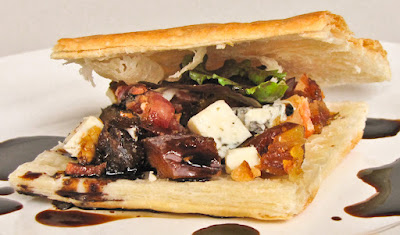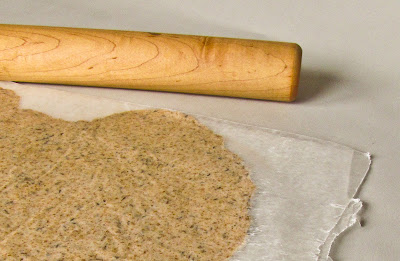Shrimp and Grits - that's a tempting entree or appetizer in any month, so don't wait for Mardi Gras to indulge.
Picture a bowl of decadent cheesy grits, finished with a bit of cream and butter, tucked beneath sweet wild shrimp and sauced with a zingy andouille gravy. Garnished with a gremolata of lemon zest, parsley and green onion, mmmm mmm, that’s comfort food at its best. If you just can’t resist the temptation, go ahead and add some crispy bacon bits, but the dish is plenty tasty without them.
Before any food purists shout out that “real” Low Country Grits don't feature cheese or dairy, I’ll admit this recipe could be non-traditional. Too bad, I like my grits this way. For the best results use stone-ground grits rather than the instant or quick-cook varieties that come in a box. It’s a textural thing, a different mouth-feel that in no way resembles the dreaded Cream of Wheat cereal of my youth.
The shrimp and sauce part of the recipe tends to change each time I prepare this dish. Variations spring from suggestions in cookbooks or online sources (like this and this) and it’s fun to mess with the basic recipe. Last Saturday's version for a Mardi Gras Potluck Party was based on a Tyler Florence recipe, found online and in his cookbook, “Stirring the Pot”.
Some of the best suggestions come from the online readers’ comments. For example, an alcohol reduction* blended into the roux added extra depth and richness to balance the zing of cayenne and hot sauce. Not knowing the heat tolerance of the partygoers, I kept this batch on the mild side. Bottles of Cajun Sunshine and Green Tabasco sauce let everyone add heat as desired.
Note to self: the andouille gravy mellows and loses some of it's spicy heat when prepared a day ahead of time.
Shrimp and Grits
Recipe based on Ultimate Shrimp and Grits by Tyler Florence
Serves 4-6 an an entree
Grits:
2 cups chicken stock
1/2 cup milk
1 cup stone-ground grits
1/2 cup heavy cream
1 tablespoon unsalted butter
1/2 cup shredded cheese (any mild, white, meltable not stringy when heated variety)
Kosher salt and white pepper
Shrimp:
2 tablespoons extra-virgin olive oil
1 medium white onion, minced
1 garlic clove, minced
1 pound spicy sausage, cut in chunks (andouille, chorizo, spicy Italian, etc)
2 tablespoons all-purpose flour
2 cups chicken stock
1 bay leaf
2 pounds large shrimp, peeled and deveined
Kosher salt and freshly ground black pepper
2 tablespoons finely chopped fresh flat-leaf parsley
1 green onion, white and green part, chopped
Zest of 1 lemon
Hot sauce and/or cayenne pepper to taste
To make the grits, place a 3-quart pot over medium-high heat. Add the chicken stock and bring to a boil. Add the milk and slowly whisk in the grits. When the grits begin to bubble, reduce the heat to medium-low and simmer, stirring frequently with a wooden spoon so the grits don't stick and scorch. Cook according to the package directions, or until the mixture is smooth and thick. Remove from heat and stir in the cream, cheese and butter; season with salt and pepper to taste. Add more cream as desired for looser grits; they will set up and thicken a bit as they stand.
To make the shrimp, place a deep skillet over medium heat and coat with the olive oil. Add the onion and garlic; saute for 2 minutes to soften, not brown. Add the sausage and cook, stirring, until there is a fair amount of fat in the pan and the sausage is brown. Sprinkle in the flour and stir with a wooden spoon to create a roux. Slowly pour in the chicken stock and continue to stir to avoid lumps. Toss in the bay leaf. When the liquid comes to a simmer, add the shrimp. Poach the shrimp in the stock for 2 to 3 minutes, until they are firm and pink and the gravy is smooth and thick. Remove from the heat. Do not overcook the shrimp! Season with salt and pepper; add cayenne and/or hot sauce to taste. Stir in half of the parsley, lemon zest and green onion.
To serve, spoon the grits into a serving bowl or into individual bowls. Add the sauced shrimp mixture and garnish with the remaining parsley, lemon zest and green onion. Serve immediately, with extra hot sauce available.
Notes:
- Use really good, spicy sausage; I prefer andouille or a mix of andouille and chorizo.
- Shrimp shells simmered in the chicken stock add extra flavor. Discard the shells before adding the stock to the roux.
- Alcohol Reduction*: For the liquid, I used the chicken broth, but I also brought to a boil about 1 scant cup of dry white wine, about 3/4 cup of a dark lager and a jigger of Kentucky bourbon. I slowly reduced it all down to about 1/3, and added it to the gravy along with a bit of butter just before serving. It sounds like a bit of a bother, but it really added a richness of flavor.
- The Cajun Sunshine contributed a sweet, mild heat to the dish, without the harshness of cayenne. It may be hard to locate, but it's worth the search.
Laissez les bons temps rouler!































